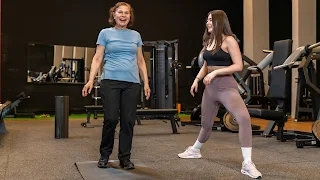8 Expert-Recommended Exercises to Help Aging Parents Build Strength and Balance
As our parents age, it becomes increasingly important to support their physical health—not just for longevity, but for independence, confidence, and quality of life. While aging naturally brings physical changes, consistent movement and targeted exercise can make a powerful difference.
That’s why personal trainer [Insert Trainer's Name], who works with older adults, designed a simple, effective routine for her own parents. These eight foundational exercises focus on strength, balance, and stability, all critical for preventing falls, preserving mobility, and maintaining daily function.
Whether your parents are new to exercise or returning after a break, this routine is safe, accessible, and highly effective.
Why Strength and Balance Matter for Older Adults
As we age, we tend to lose muscle mass (sarcopenia) and bone density, which increases the risk of falls, fractures, and reduced mobility. In fact, falls are a leading cause of injury among seniors.
But the good news? Regular strength and balance training can:
-
Improve posture and joint health
-
Enhance coordination and stability
-
Increase confidence in daily movement
-
Support independence in tasks like walking, climbing stairs, or getting up from a chair
These eight moves can be done at home with minimal equipment. Always encourage your parents to get medical clearance before starting a new exercise routine, especially if they have chronic conditions.
The 8 Best Exercises for Aging Parents
1. Sit-to-Stand
-
Why it helps: Builds leg strength and simulates everyday movement (like rising from a chair).
-
How to do it: Sit in a sturdy chair, feet hip-width apart. Stand up slowly, then sit down with control. Use arms as needed.
-
Reps: 10–12 reps, 2–3 sets
2. Wall Push-Ups
-
Why it helps: Strengthens upper body and supports shoulder mobility.
-
How to do it: Stand about two feet from a wall. Place hands shoulder-width apart on the wall and perform a push-up by bending the elbows and returning to start.
-
Reps: 10–15 reps, 2 sets
3. Heel-to-Toe Walk (Tandem Walk)
-
Why it helps: Improves balance and coordination.
-
How to do it: Walk in a straight line, placing the heel of one foot directly in front of the toes of the other. Use a wall or chair for support if needed.
-
Duration: 20 steps, 2–3 rounds
4. Marching in Place
-
Why it helps: Enhances hip flexor strength and dynamic balance.
-
How to do it: While standing tall, march in place, lifting knees as high as is comfortable.
-
Time: 30–60 seconds, 2 rounds
5. Standing Calf Raises
-
Why it helps: Strengthens the lower legs and improves ankle stability.
-
How to do it: Stand behind a chair for support. Raise heels off the ground, hold for 1–2 seconds, then slowly lower.
-
Reps: 10–15 reps, 2 sets
6. Step-Ups
-
Why it helps: Builds leg strength and mimics climbing stairs.
-
How to do it: Step up onto a low step or sturdy platform, then step back down. Alternate leading legs.
-
Reps: 10 reps per leg, 2 sets
7. Single-Leg Stand
-
Why it helps: Trains static balance and core stability.
-
How to do it: Stand on one leg for up to 30 seconds, using a chair or counter for support if needed. Repeat on the other leg.
-
Reps: 2 times per leg
8. Seated Knee Extensions
-
Why it helps: Strengthens the quadriceps, which support knee and hip function.
-
How to do it: Sit in a chair. Straighten one leg out in front, hold for 2 seconds, then lower. Alternate legs.
-
Reps: 10–12 reps per leg, 2 sets
Tips for Success
-
Start slow: Even a few reps per day make a difference over time.
-
Stay consistent: Aim for at least 3 sessions per week.
-
Make it social: Encourage siblings or caregivers to join in or offer encouragement.
-
Track progress: Keep a log of reps and balance time to stay motivated.
When to Consult a Professional
If your parents have arthritis, joint pain, osteoporosis, or have had previous falls, it’s smart to consult a physical therapist or certified trainer who specializes in aging populations. A professional can personalize movements for safety and maximize results.
🧠 Final Thoughts
Helping our parents stay strong and balanced isn’t just about preventing falls—it’s about empowering them to enjoy life with confidence. These eight exercises form a powerful foundation for physical independence and overall well-being.
Encourage your parents to move at their own pace, celebrate small wins, and most importantly—keep moving.
Want more expert tips on healthy aging, strength training, and home workouts?
Sign up for our weekly wellness newsletter [Insert link]
Or download our free guide: "Staying Strong After 60: A Beginner’s Exercise Plan"
